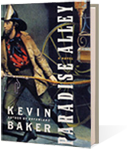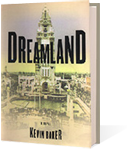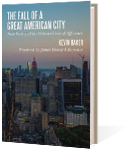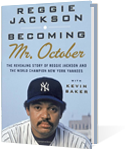Ken Burns gets served.
By Kevin Baker
It’s not every day that you pick up the newspaper and read that three of your friends have been subpoenaed—assuming, that is, that you don’t work for an international bank, the mafia, or the New York State Assembly.
The friends in question are the documentary filmmaker Ken Burns, his daughter, the author and filmmaker Sarah Burns, and Sarah’s husband, David McMahon, who has worked with Ken for the last 14 years. I first met and worked with them all when I consulted on the updated version of Ken Burns’s Baseball series and wrote a new chapter for the accompanying book.
The subpoena involves a new documentary the three of them are making called The Central Park Five, an adaptation of the book Sarah Burns published earlier this year, The Central Park Five: Chronicle of a City Wilding, which revisits the brutal rape of Trisha Meili, the 28-year-old investment banker who would be known ever after as “the Central Park jogger.”
The attack was yet another polarizing moment in a city that at the time seemed irretrievably divided by race. A then-familiar chorus of racial demagogues—led by the as-yet-unsanitized Al Sharpton—eagerly politicized the trial of the five teenagers accused of this atrocity. Worse, though, were the actions of the police, Linda Fairstein, head of the sex-crimes unit of the Manhattan District Attorney’s Office, and prosecutor Elizabeth Lederer, who wheedled false confessions out of the accused teens and put them away for lengthy prison sentences.
Why would the cops and the District Attorney’s Office railroad a bunch of young men for a crime they didn’t commit? The Central Park Five were part of a group of a group of 30 to 40 teens from the East Harlem housing projects who entered the park on the night in question—April 19, 1989—looking for a little blood-sport. They savagely attacked anyone they encountered, including a homeless man, a couple riding a tandem bike and several joggers running around the reservoir. It’s easy enough to see, when Ms. Meili was discovered not far away that same night, her skull smashed and most of her blood gone, how the cops and the prosecutors must have figured, So what if we don’t have the exact right subset of these sociopaths—what does it matter?
It mattered. An even scarier young man, one Matias Reyes, had been committing a series of assaults and rapes in the area. The police nearly apprehended him after a hospital reported a patient with suspicious wounds, but somehow a planned arrest never took place. Well, that sort of thing happens. On the night of the rape, Mr. Reyes was leaving the park when an officer delivering mail to the Central Park precinct stopped to ask him about reports of assaults coming in. Mr. Reyes told him he didn’t know anything about that, and the officer sent him on his way without even shining his flashlight on him.
If he had, he would have discovered that Mr. Reyes was covered in blood—Ms. Meili’s blood. A few months later, Mr. Reyes went on to rape and kill another young woman, Lourdes Gonzalez, in front of her three young children. A few months after that, he was caught while running out to try to get a pair of scissors with which to blind yet another rape victim.
In 2002, Mr. Reyes confessed to the jogger’s rape, and the evidence supported his admission. Manhattan District Attorney Robert Morgenthau acknowledged his department’s mistakes, but by then, the five teens in question had done their time.
For this crime, at least, the innocence of the Central Park Five is no longer disputed.
Except by the NYPD, which soon after Mr. Reyes’s confession formed its own panel to quickly exonerate itself. The group—consisting of a former prosecutor, a former cop and an active deputy police commissioner—came up with a whole new theory of the case, conceding that Mr. Reyes did it, but insisting that the five teens must have helped him, and “subjected [the jogger] to some sort of attack.”
Everybody knew what was coming—a $250 million lawsuit by the Central Park Five, which the NYPD has now spent nine years fighting at untold public expense. The department has also spent years refusing to be interviewed for the Burns book and film. But now comes the subpoena, demanding the outtakes from the documentary, supposedly to help the city defend itself.
“We believe that, based on the information that the police and prosecutors had at the time, they had probable cause to proceed and the confessions were sound,” announced Celeste Koeleveld, the city’s executive assistant corporation counsel for public safety.
This is a baldfaced lie. DNA evidence was in its infancy in 1989—but none of the samples matched the defendants. Nor did any of the other forensics.
“Mr. Burns and his daughter have publicly sided with the plaintiffs and their families, who are seeking hundreds of millions from New York City,” Ms. Koeleveld also noted. “The movie has crossed from documentary to pure advocacy.”
This is another lie, as well as an indication that Ms. Koeleveld should have paid more attention during her constitutional law classes. The documentary—like the book—is about as fair-minded as possible, considering the NYPD’s and the city’s stonewalling. And good journalism is advocacy, Ms. Koeleveld. That’s why we have the First Amendment, not so we can get the latest on the Kardashians. It’s about advocating for the correction of a serious injustice. And all public servants—even the police—ought to be obliged to give a full and truthful accounting of their actions to the people they serve.
In reading and watching the Burns’s work, I was struck by the fact that police never responded to any of the assaults on the night of the jogger’s rape until several victims managed to make their way to the park station house. Yet the vicious assaults perpetrated by that gang of marauding teenagers took place along the main roads through the park and around the reservoir jogging track—which is a very weak stone’s throw from the police station.
It’s hard not to conclude that the police had by then all but given up policing the park, whether because of demoralization or lack of resources.
Today, of course, we’re assured that New York is run much more like a “business,” and such things couldn’t possibly happen. But like many real American businesses, it seems better at downsizing personnel and tweaking statistics to conceal failure than at serving the public.
Attempts to rein in the NYPD’s racially skewed “stop-and-frisk” tactics were answered with police commissioner Ray Kelly snarling his contempt at the City Council. Two recent incidents in Midtown involving deranged men triggered wild police fusillades, killing the suspects and wounding six innocent passers-by. Another mentally troubled suspect, Hawa Bah, died in a similar hail of bullets in his Harlem apartment after he tried to attack officers with a knife.
These are signs of a police department under stress, trying to do too much with too little. Recently, too, we’ve seen the disturbing 5 a.m. rape of a young actress in Hudson River Park and the daylight rape of a 73-year-old woman in Central Park by a man she had reported days earlier for publicly masturbating.
Crime is now ticking up in New York, for the first time in 20 years. The response of our political establishment has been to keep cutting resources—the number of police has been slashed by 6,000 since 2001—while denying reality.
Reports now abound of citizens who try to report crimes only to be interrogated themselves by officers who suggest that perhaps they’re making up stories; I know some of these people myself. Not long ago, I went to my local precinct house to report an unhinged individual dancing, raving and stripping off his clothes on the corner about a block away. A nice civilian employee there told me that the police were “all busy,” and handed me a card with a number for a narcotics squad. The number no longer worked.
The hard fact is that the rise in crime will not be countered by rounding up all the black teenagers with a joint in their pockets, or firing volleys down crowded streets, or having desk sergeants stick their fingers in their ears and go ‘la-la-la-la’ whenever anybody comes in to report an offense.
Of course, we could always subpoena more movie outtakes.









